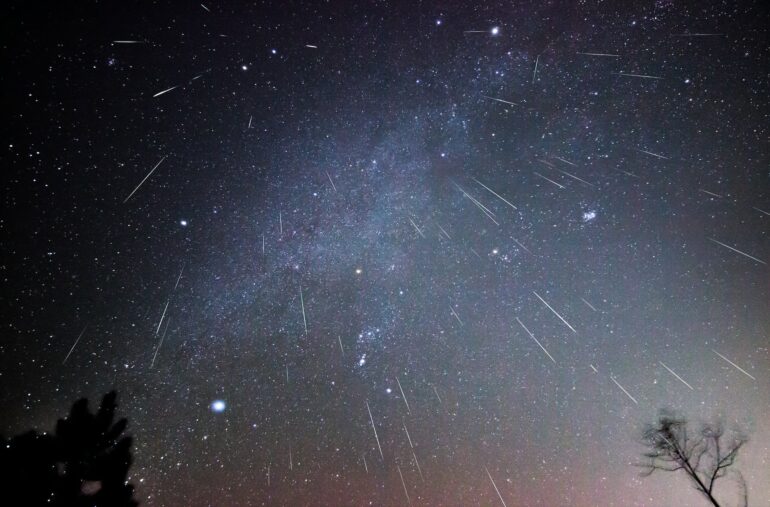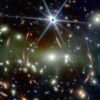The Geminids meteoroids light up the sky as they race past Earth each winter, producing one of the most intense meteor showers in our night sky.
Mysteries surrounding the origin of this meteoroid stream have long fascinated scientists because, while most meteor showers are created when a comet emits a tail of ice and dust, the Geminids stem from an asteroid—a chunk of rock that normally does not produce a tail. Until recently, the Geminids had only been studied from Earth.
Now, Princeton researchers used observations from NASA’s Parker Solar Probe mission to deduce that it was likely a violent, catastrophic event—such as a high-speed collision with another body or a gaseous explosion—that created the Geminids. The findings, which were published in The Planetary Science Journal, narrow down hypotheses about this asteroid’s composition and history that would explain its unconventional behavior.
“Asteroids are like little time capsules for the formation of our solar system,” said Jamey Szalay, research scholar at the Princeton University space physics laboratory and co-author on the paper. “They were formed when our solar system was formed, and understanding their composition gives us another piece of the story.”
An unusual asteroid
Unlike most known meteor showers that come from comets, which are made of ice and dust, the Geminids stream seems to originate from an asteroid—a chunk of rock and metal—called 3200 Phaethon.
“Most meteoroid streams are formed via a cometary mechanism, it’s unusual that this one seems to be from an asteroid,” said Wolf Cukier, undergraduate class of 2024 at Princeton and lead author on the paper.
“Additionally, the stream is orbiting slightly outside of its parent body when it’s closest to the sun, which isn’t obvious to explain just by looking at it,” he added, referring to a recent study with Parker Solar Probe images of the Geminids led by Karl Battams of the Naval Research Laboratory.
When a comet travels close to the sun it gets hotter, causing the ice on the surface to release a tail of gas, which in turn drags with it little pieces of ice and dust. This material continues to trail behind the comet as it stays within the sun’s gravitational pull. Over time, this repeated process fills the orbit of the parent body with material to form a meteoroid stream.
But because asteroids like 3200 Phaethon are made of rock and metal, they are not typically affected by the sun’s heat the way comets are, leaving scientists to wonder what causes the formation of 3200 Phaethon’s stream across the night sky.
“What’s really weird is that we know that 3200 Phaethon is an asteroid, but as it flies by the sun, it seems to have some kind of temperature-driven activity,” Szalay said. “Most asteroids don’t do that.”
Some researchers have suggested that 3200 Phaethon may actually be a comet that lost all of its snow, leaving only a rocky core resembling an asteroid. But the new Parker Solar Probe data show that although some of 3200 Phaethon’s activity is related to temperature, the creation of the Geminids stream was likely not caused by a cometary mechanism, but by something much more catastrophic.
Opening the time capsule
To learn about the origin of the Geminids stream, Cukier and Szalay used the new Parker Solar Probe data to model three possible formation scenarios, then compared these models to existing models created from Earth-based observations.
“There are what’s called the ‘basic’ model of formation of a meteoroid stream, and the ‘violent’ creation model,” Cukier said. “It’s called ‘basic’ because it’s the most straight-forward thing to model, but really these processes are both violent, just different degrees of violence.”
These different models reflect the chain of events that would transpire according to the laws of physics based on different scenarios. For example, Cukier used the basic model to simulate all of the chunks of material releasing from the asteroid with zero relative velocity—or with no speed or direction relative to 3200 Phaethon—to see what the resulting orbit would look like and compare it to the orbit shown by the Parker Solar Probe probe data.
He then used the violent creation model to simulate the material releasing from the asteroid with a relative velocity of up to one kilometer per hour, as if the pieces were knocked loose by a sudden, violent event.
He also simulated the cometary model—the mechanism behind the formation of most meteoroid streams. The resulting simulated orbit matched the least with the way the Geminids orbit actually appears according to the Parker Solar Probe data, so they ruled out this scenario.
In comparing the simulated orbits from each of the models, the team found that the violent models were most consistent with the Parker Solar Probe data, meaning it’s likely that a sudden, violent event—such as a high-speed collision with another body or a gaseous explosion, among other possibilities—created the Geminids stream.
The research builds on the work of Szalay and several colleagues of the Parker Solar Probe mission, built and assembled at the Johns Hopkins Applied Physics Laboratory (APL) in Laurel, Maryland, to assemble a picture of the structure and behavior of the large cloud of dust that swirls through the innermost solar system.
They took advantage of Parker’s flight path—an orbit that swings it just millions of miles from the sun, closer than any spacecraft in history—to get the best direct look at the dusty cloud of grains shed from passing comets and asteroids.
Although the probe doesn’t measure dust particles directly, it can track dust grains in a clever way: as dust grains pelt the spacecraft along its path, the high-velocity impacts create plasma clouds. These impact clouds produce unique signals in electric potential that are picked up by several sensors on the probe’s FIELDS instrument, which is designed to measure the electric and magnetic fields near the sun.
“The first-of-its-kind data our spacecraft is gathering now will be analyzed for decades to come,” said Nour Raouafi, Parker Solar Probe project scientist at APL. “And it’s exciting to see scientists of all levels and skills digging into it to shed light on the sun, the solar system and the universe beyond.”
Reaching for the stars
Cukier said his passion for learning about outer space combined with departmental support are what motivated him to pursue this project.
After taking a hands-on lab class offered by the Princeton space physics laboratory—where he gained practical experience building space instruments, like those currently sampling the sun’s environment aboard Parker Solar Probe—and serving as treasurer for the undergraduate astronomy club, he decided he wanted to pursue extracurricular research.
He was met with enthusiasm when he reached out to scientists in the Princeton Space Physics group. “Everyone is very supportive of undergraduate research, especially in astrophysics, because it’s really part of the departmental culture,” he said.
“It’s always wonderful when our students like Wolf can contribute so strongly to this sort of space research,” said David McComas, head of the Space Physics group and vice president for the Princeton Plasma Physics Laboratory (PPPL). “Many of us have been in awe of the Geminids meteor displays for years and it is awesome to finally have the data and research to show how they likely formed.”
Cukier said that he’s been drawn to watching the sky since he was a kid. “Planetary science is surprisingly accessible,” he said. “For the Geminids, for instance, anyone can go outside on December 14 this year at night and look up. It’s visible from Princeton, and some of the meteors are really bright. I’d highly recommend seeing it.”
More information:
W. Z. Cukier et al, Formation, Structure, and Detectability of the Geminids Meteoroid Stream, The Planetary Science Journal (2023). DOI: 10.3847/PSJ/acd538
Provided by
Princeton University
Citation:
Researchers demystify the unusual origin of the Geminids meteor shower (2023, June 15)



